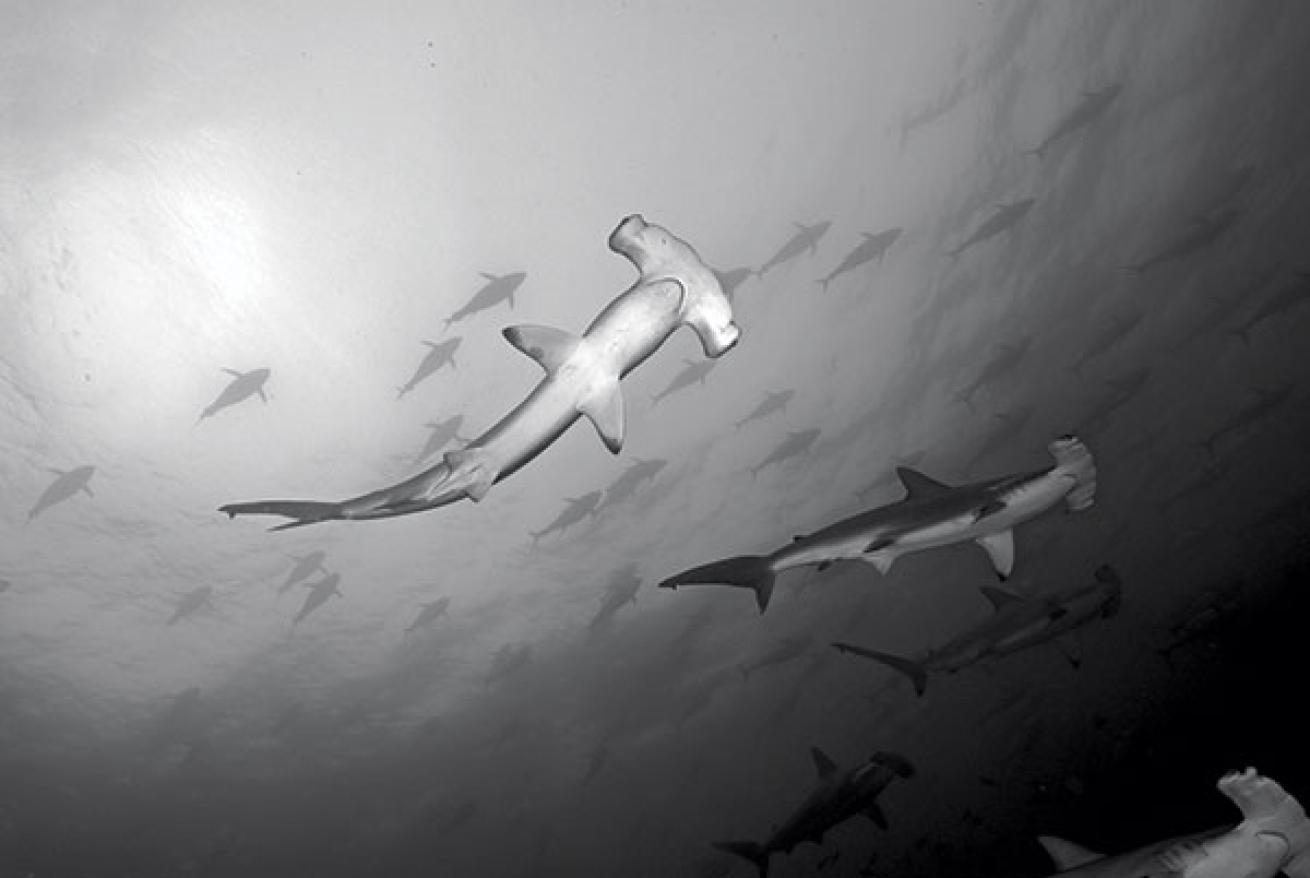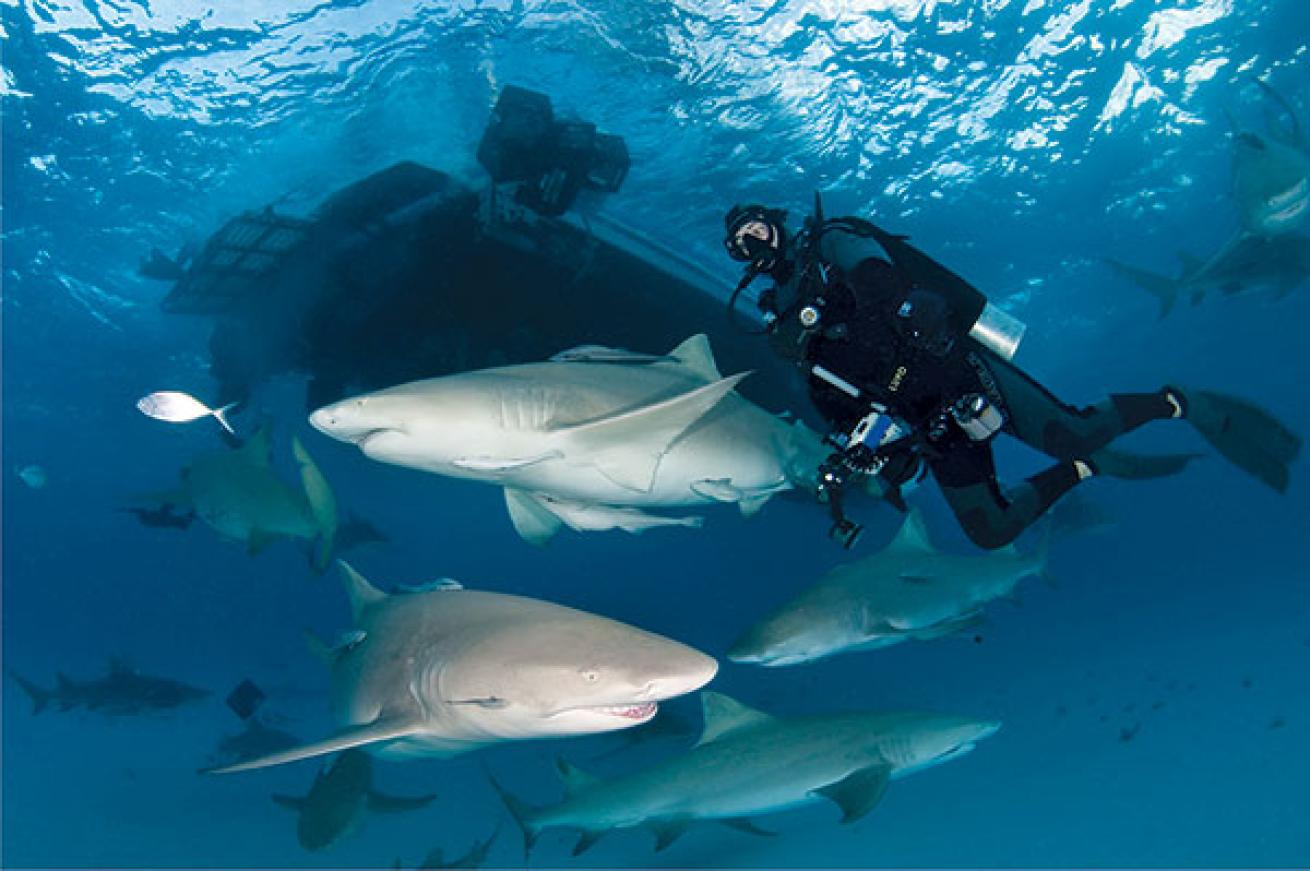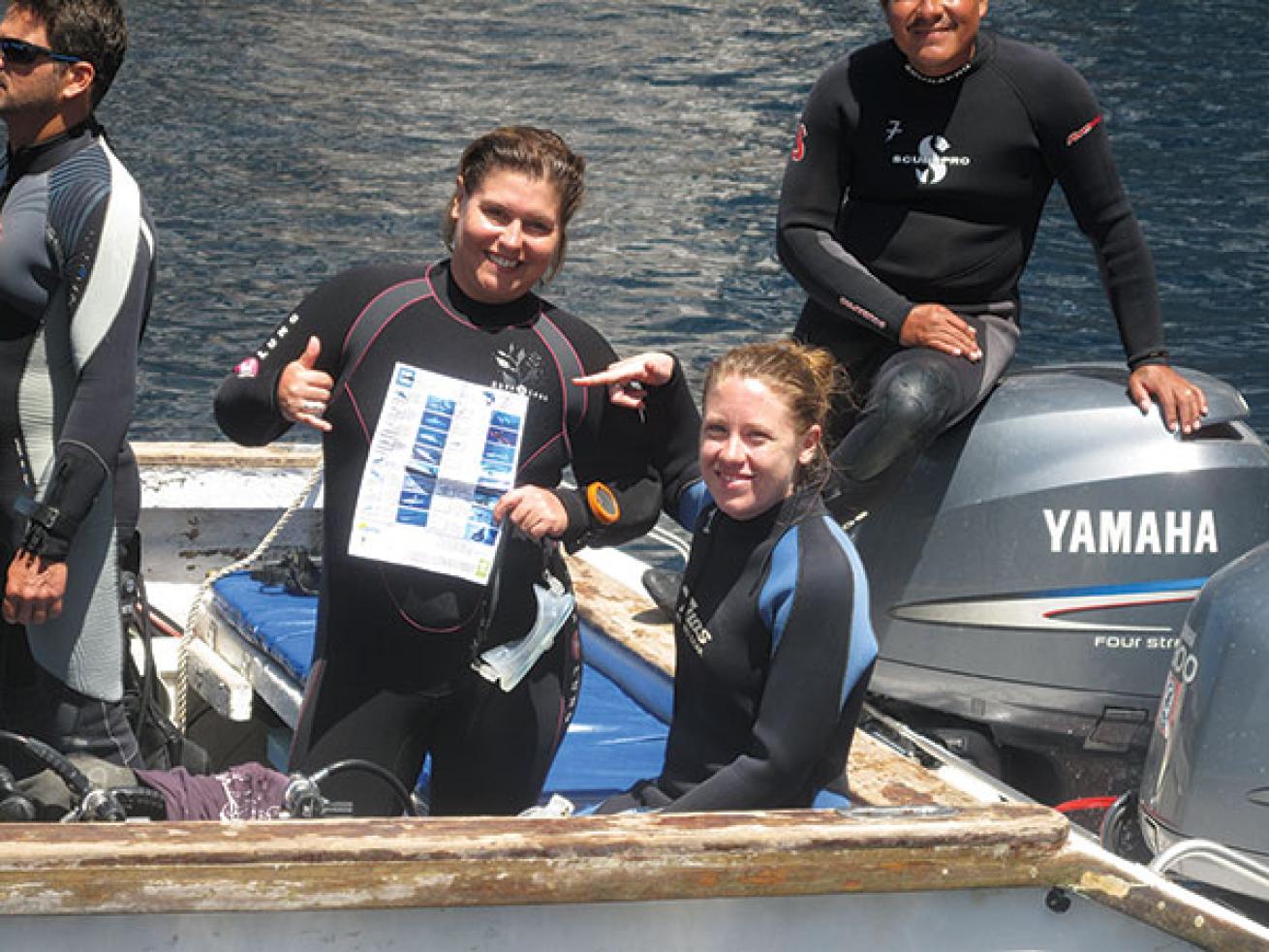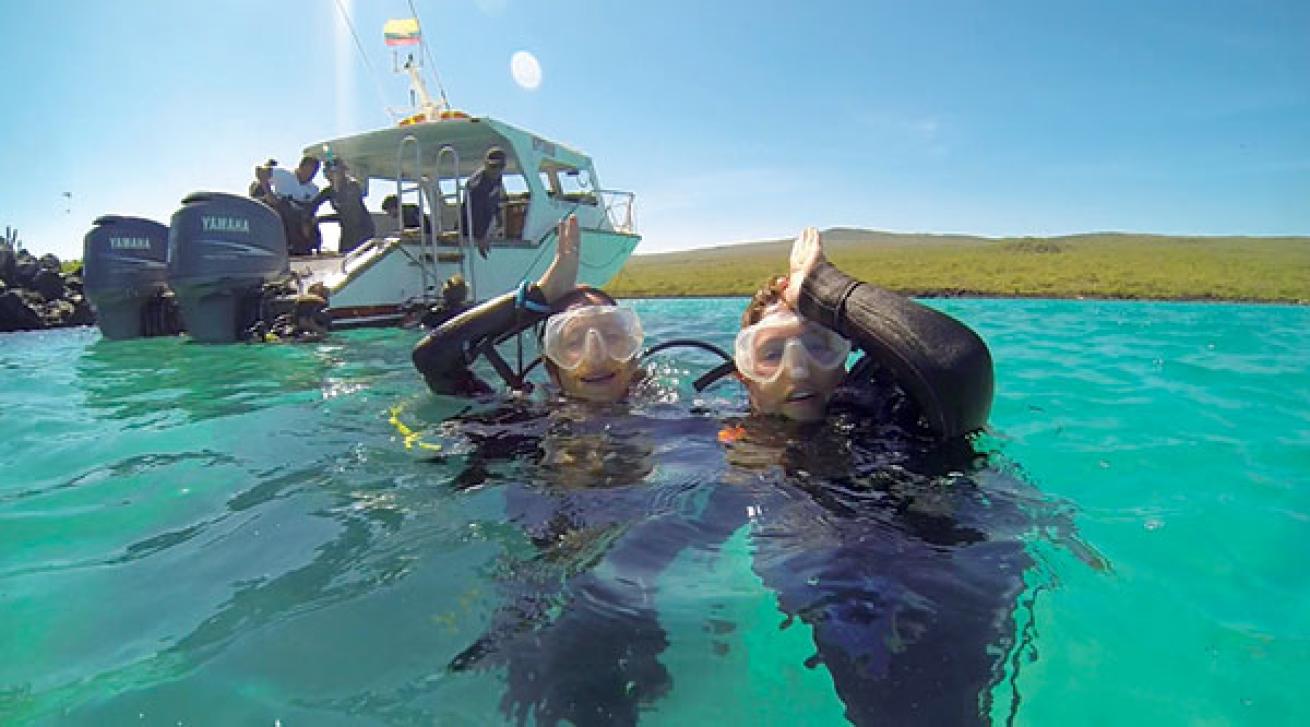Every Shark Counts: Citizen-Scientist Divers Promote Shark Conservation
Right now, somewhere underwater, recreational divers are documenting what they see — reef fish, corals, and now sharks too.
“Citizen science” refers to a network of volunteers, usually with little or no specific scientific training, performing tasks such as recording species observations to reveal local trends. In 1900, the Audubon Society started the annual Christmas Bird Count — the longest-running and largest citizen-science program — to replace a holiday tradition of shooting as many birds as possible, which had early conservationists concerned about impacts to local bird populations. Divers are familiar with citizen science through programs such as Reef Check and REEF, which log individual species sightings.
Today’s conservationists, and many divers, have concerns about shark populations. While shark diving is gaining popularity, the very first generation of recreational divers has experienced a shifting baseline in the frequency of shark sightings. These divers recall the days when a favorite dive site provided exciting shark encounters but where sightings now are far less frequent, or nonexistent. Scientists have reported declines of 90 percent or more for some species in some parts of their ranges — 89 percent in hammerhead sharks, 79 percent in great white sharks and 65 percent in tiger sharks over the past few decades due to over-fishing the northeast Atlantic Ocean. The International Union for the Conservation of Nature lists one in six species of sharks (and their relatives skates, rays and chimera) as threatened, and still more shark species are listed as “data deficient.”
Increasing protections for sharks requires information about local populations. Until recently, however, recreational divers weren’t routinely documenting their sightings. This valuable knowledge wasn’t captured because divers didn’t have the basic training or simple tools to log shark sightings in a way that could be useful for shark conservation, management and advocacy.
But that’s all changing. Projects such as SharksCount — part of WildAid's Shark Savers program — the eShark database and ECO-Ocean’s whale shark photo-ID library are providing tools for recreational divers everywhere to become citizen scientists for sharks.
The goals are generally long-term: To collect shark sightings over decades and build a large database to help provide a clearer understanding of when and where sharks are seen. But the information has short-term value also.
“I**** recently needed to find more lemon sharks to tag for my research study in Florida,” explains shark biologist Dr. Steve Kessel. “SharksCount provided me with data on where their divers had seen and logged these sharks, and those data helped me to find them much more effectively, a great example of how regional citizen-science programs can work in conjunction with scientific research.”
The Global Shark Assessments’ results from 75,000 recreational dives in the Caribbean revealed that divers are far less likely to see sharks in areas with concentrated human populations or fishing fleets, and more likely in areas with strong protections for sharks.
In addition to the scientific value, these projects also promote sustainable, responsible shark eco-tourism. As more people are introduced to shark diving and the fun of logging their sightings, live sharks become increasingly recognized for their value to local economies.
Now, adventure travelers new to shark conservation are learning to count sharks. For example, Contiki Holidays and Jacques-Yves Cousteau’s granddaughter Céline recently included SharksCount training for their travelers in Ecuador, to inspire them to log their shark sightings wherever and whenever they travel.
“Not only are sharks and shark research benefiting, but visitors get to be involved and support this crucial work too,” says Cousteau.
Get Involved:
SharksCount, a Shark Savers program at WildAid, promotes citizen science for sharks by providing divers with simple and fun tools to log their shark sightings (and absence of sightings) for conservation applications. SharksCount provides data, materials and support for the Great Fiji Shark Count, surveys in Indonesia and on-site or virtual training all over the world. SharksCount partners with scientists, communities and dive operators globally.
>****Donate Support our shark programs at wildaid.org.
>****Like Us Like Sharks- Count on Facebook, and tell others about us.
>****Sign Up Email us to sign up as a counter at SharksCount@ sharksavers.org.
>****Join a Shark Count Every April and November is the Great Fiji Shark Count. Find out how you can participate at fijisharkcount.com.
Visit sharksavers.org to learn more about counting sharks.

Ethan Gordon
The hammerhead shark's eyes and nostrils are at the tips of its hammer-shaped extensions. This is a fairly large hammerhead, though is smaller than great and smooth hammerheads. Scalloped hammers ares also known as bronze, kidney-headed or southern hammerhead.

Mary O'Malley
Counting Bahamian lemon sharks. The lemon shark is a stocky, powerful shark named for its yellow color, a a perfect camouflage when it is swimming over the sandy seafloor in its coastal habitat.

Jennah CasterShark ID cards are used to track sharks in the SharksCount initiative.

Courtesy SharksCountThe author Samantha Whitcraft (at right) and Céline Cousteau.
Right now, somewhere underwater, recreational divers are documenting what they see — reef fish, corals, and now sharks too.
“Citizen science” refers to a network of volunteers, usually with little or no specific scientific training, performing tasks such as recording species observations to reveal local trends. In 1900, the Audubon Society started the annual Christmas Bird Count — the longest-running and largest citizen-science program — to replace a holiday tradition of shooting as many birds as possible, which had early conservationists concerned about impacts to local bird populations. Divers are familiar with citizen science through programs such as Reef Check and REEF, which log individual species sightings.
Today’s conservationists, and many divers, have concerns about shark populations. While shark diving is gaining popularity, the very first generation of recreational divers has experienced a shifting baseline in the frequency of shark sightings. These divers recall the days when a favorite dive site provided exciting shark encounters but where sightings now are far less frequent, or nonexistent. Scientists have reported declines of 90 percent or more for some species in some parts of their ranges — 89 percent in hammerhead sharks, 79 percent in great white sharks and 65 percent in tiger sharks over the past few decades due to over-fishing the northeast Atlantic Ocean. The International Union for the Conservation of Nature lists one in six species of sharks (and their relatives skates, rays and chimera) as threatened, and still more shark species are listed as “data deficient.”
Increasing protections for sharks requires information about local populations. Until recently, however, recreational divers weren’t routinely documenting their sightings. This valuable knowledge wasn’t captured because divers didn’t have the basic training or simple tools to log shark sightings in a way that could be useful for shark conservation, management and advocacy.
But that’s all changing. Projects such as SharksCount — part of WildAid's Shark Savers program — the eShark database and ECO-Ocean’s whale shark photo-ID library are providing tools for recreational divers everywhere to become citizen scientists for sharks.
The goals are generally long-term: To collect shark sightings over decades and build a large database to help provide a clearer understanding of when and where sharks are seen. But the information has short-term value also.
“I**** recently needed to find more lemon sharks to tag for my research study in Florida,” explains shark biologist Dr. Steve Kessel. “SharksCount provided me with data on where their divers had seen and logged these sharks, and those data helped me to find them much more effectively, a great example of how regional citizen-science programs can work in conjunction with scientific research.”
The Global Shark Assessments’ results from 75,000 recreational dives in the Caribbean revealed that divers are far less likely to see sharks in areas with concentrated human populations or fishing fleets, and more likely in areas with strong protections for sharks.
In addition to the scientific value, these projects also promote sustainable, responsible shark eco-tourism. As more people are introduced to shark diving and the fun of logging their sightings, live sharks become increasingly recognized for their value to local economies.
Now, adventure travelers new to shark conservation are learning to count sharks. For example, Contiki Holidays and Jacques-Yves Cousteau’s granddaughter Céline recently included SharksCount training for their travelers in Ecuador, to inspire them to log their shark sightings wherever and whenever they travel.
“Not only are sharks and shark research benefiting, but visitors get to be involved and support this crucial work too,” says Cousteau.
Get Involved:
SharksCount, a Shark Savers program at WildAid, promotes citizen science for sharks by providing divers with simple and fun tools to log their shark sightings (and absence of sightings) for conservation applications. SharksCount provides data, materials and support for the Great Fiji Shark Count, surveys in Indonesia and on-site or virtual training all over the world. SharksCount partners with scientists, communities and dive operators globally.
>****Donate Support our shark programs at wildaid.org.
>****Like Us Like Sharks- Count on Facebook, and tell others about us.
>****Sign Up Email us to sign up as a counter at SharksCount@ sharksavers.org.
>****Join a Shark Count Every April and November is the Great Fiji Shark Count. Find out how you can participate at fijisharkcount.com.
Visit sharksavers.org to learn more about counting sharks.










